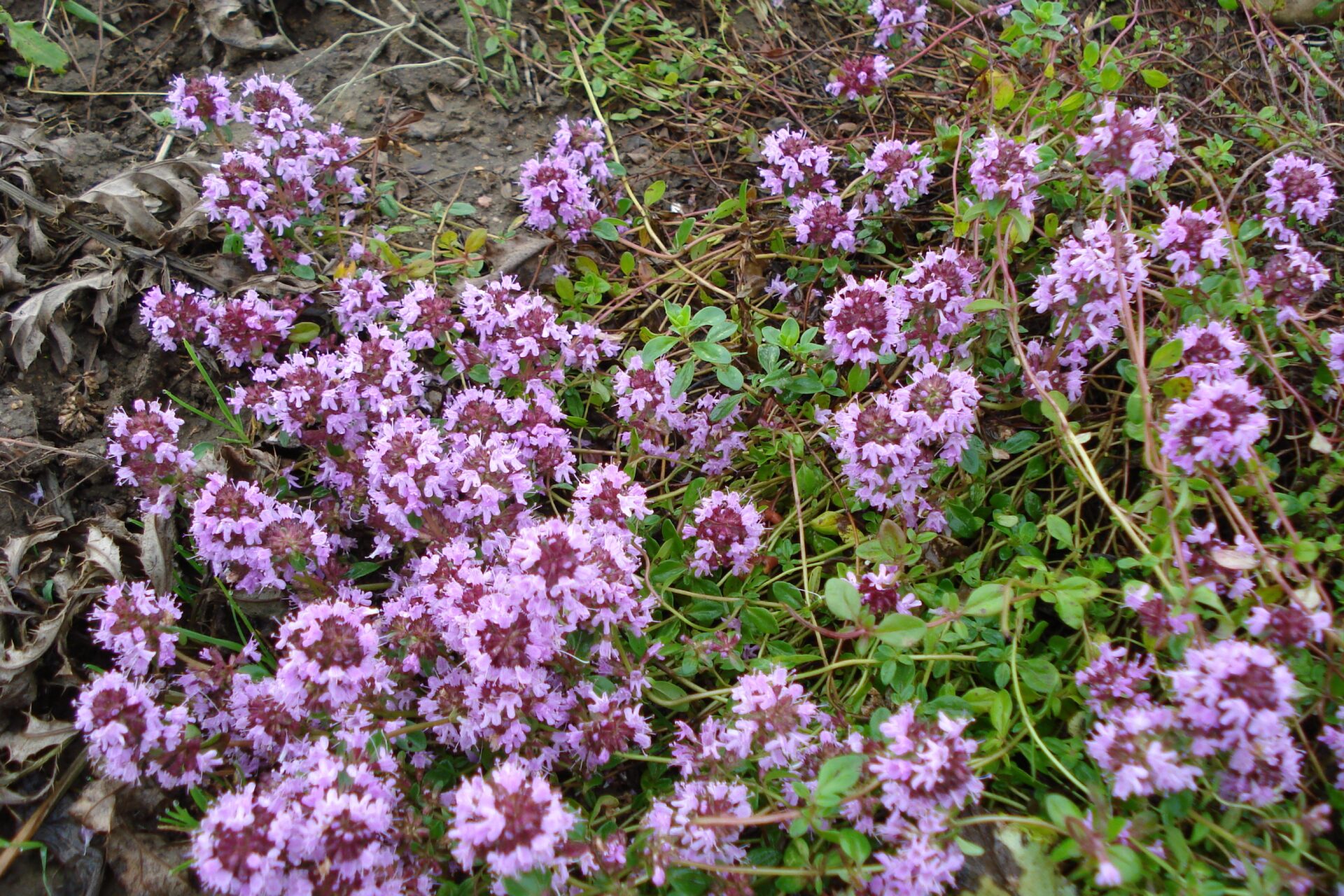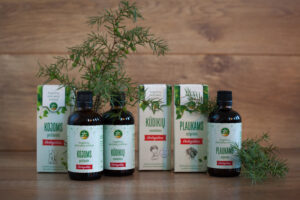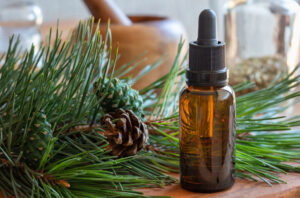Thyme (Thymus vulgaris, Thymus serpyllum L)
Plant family Lamiaceae (Labiatae)
Sinonimai
Common thyme, red thyme, white thyme, wild thyme
Kilmė
Thyme originates from Mediterranean Europe and is widely cultivated as a spice. It has also been used as a medicinal herb for thousands of years, primarily as an antiseptic for respiratory and digestive disorders.
Gamybos būdas
Steam distillation of flowering tops and leaves. The plant produces two types of thyme oil: red thyme is a crude distillate, while white thyme oil is obtained by further distillation or rectification. Up to 35-50 kg of fresh thyme herb is needed to produce 1 kg of essential oil.
Aliejaus pobūdis
Red thyme oil is a reddish-brown liquid with a strong, warm, spicy-herbal smell. White thyme oil has a fresh, herbaceous smell, sweeter and slightly milder than red thyme oil, and is colourless or pale yellow.
Aroma note from top to middle. The aroma lasts 1-2 days.
Pagrindinės sudedamosios dalys:
(Thymus serpyllum L)
| p-Cymen | 10.0 -20.0% |
| Timolus | 5.0 -18.0% |
| Karvakrol | 8.0 – 16.0% |
| Geraniol | 7.0 – 14.0% |
| Linalool | 4.0 -5.0% |
| 1,8-Cineole | 0.5 – 2.0% |
| D,L-Limonene (unspecified isomer) | 1.0 – 2.0% |
| Eugenol | 0.2 – 0.5% |
| Eugenyl methyl ether | 0.4% |
Savybės
Antimicrobial, antiviral and antifungal, stimulant and strengthening, especially for the respiratory tract, for irritating dry cough, expectorant, stimulant of bile formation and gall bladder outflow, digestive, antidiarrhoeal, anti-spasmodic, analgesic, anti-rheumatism, anti-parasitic and anti-worm.
Terapinės savybės
Thyme oil is hot, spicy and stimulating. It is a powerful germicide, effective against many types of bacteria, viruses and fungi. It can be used in massage blends but can be irritating, so do not use more than 3% concentration and perform a sensitivity test on a small area of skin before use. Thyme can also be added to the bath, but it can irritate the mucous membranes and should not be used in bath oils above 1%. Add it to other strongly antiseptic oils such as clove, eucalyptus, lavender, lemon and pine and use it in a room spray for disinfecting rooms.
Thyme acts as a general nerve tonic and, like rosemary, improves brain function and memory, making it a useful tonic for any kind of exhaustion or fatigue.
The main effect of thyme is urogenital. It is one of the most important oils in the treatment of venereal infections and has been used effectively to treat non-specific urethritis (NSU), gonorrhoea, leucorrhoea and trichomoniasis. It is also effective against many types of urinary tract infections, including cystitis and pyelitis. This stimulates menstruation and will help in case of continued delays.
Thyme oil is a very effective lung antiseptic and is therefore useful in treating respiratory infections including colds, flu, coughs and especially bronchitis. It can be used in steam inhalation, as a chest rub or in an essential oil vaporiser. It is particularly useful where there is weakness associated with a respiratory infection. It is similar to eucalyptus in its expectorant properties, and is also antispasmodic, useful for spasmodic coughs and asthma.
Like tea tree, thyme has been shown to be effective in fighting infection and boosting the immune response by stimulating white blood cell production. It is one of the main essential oils used in the treatment of HIV-related diseases.
Thyme has a warming and tonic effect on the digestive system. Its antiseptic properties make it useful in the treatment of dysentery and gastroenteritis. Mix with rosemary or geranium oil and massage into the abdomen.
Thyme has a stimulating and tonic effect on the circulatory system. It can be used to treat low blood pressure and weakness. This may be useful in the case of anaemia.
As a warming and stimulating oil, thyme can be used in massage blends and baths to relieve muscle stiffness, aches and pains, rheumatism and arthritis.
Well-diluted thyme can be applied to the skin to cure infections, acne, furuncles and ulcers. It will also remove head and body lice and scabies.
Aromatherapy uses
Acne, insect bites and stings, scabies, wounds, arthritis, gout, rheumatism, muscle aches, respiratory ailments, gum problems, halitosis, tonsillitis, indigestion, indigestion, flatulence, meteoric fever, cystitis, cold and flu, infectious illnesses, nervous exhaustion, fatigue, depression.
Psichologinis profilis
Wild thyme essential oil restores and boosts self-confidence. Wild thyme essential oil is a popular aromatherapy oil for many reasons, but primarily for its ability to relieve stress. It is a very emotionally and energetically uplifting essential oil that can help combat situational depression and anxiety.
Mixes well
With bergamot, eucalyptus, lavender, lemon, lemon balm, rosemary, tea tree essential oils.
Mūsų saugos patarimai
Our maximum skin effect is based on 48. l% total thymol and carvacrol and a skin limit of 1% for this ingredient to avoid skin irritation (see Carvacrol and Timol profiles, Chapter 14).
Due to its (+) limonene content, we recommend avoiding oxidation of thyme oil (limonene CT) by storing it in a dark, airtight container in the fridge. It is recommended to add an antioxidant to preparations containing it. However, thymol and carvacrol are themselves antioxidants, so they can play this role.
Įspėjimai
Avoid during pregnancy. Another commonly used oil is wild thyme (T. serpyllum.) Unfortunately, the chemical composition of wild plants is very different, even though they may be grown in the same area. Therefore, it cannot be guaranteed that the oils from such plants will be gentle on the skin and mucous membranes.
Other species
Wild thyme (Thymus serpyllum) has very similar properties to common thyme (T. vulgaris). Lemon thyme (T. citriodorus) and linalool thyme are milder and less toxic than common thyme, making them more suitable for children.
Nuorodos:
1. C. Wildwood “The Encyclopedia of Aromatherapy”, Vermont, Healing Arts Press, 1996
2. R. Tisserand, R. Young, E. M Williamson “Essential Oil Safety. A Guide for Health Care Professionals”, Churchill Livingstone ELSEVIER, 2014
3. S. Curtis “Essential Oils”, AURUM, London, 1996
4. R. Balz “The Healing Power of Essential Oils”, LOTUS LIGHT SHANGRI-LA, Twin Lakes, 1996
5. Л.ГДудченко, Г.П.Потебня, Н.А.Кривенко «Ароматерапия и аромамасаж», «Максимум», Киев, 1999





